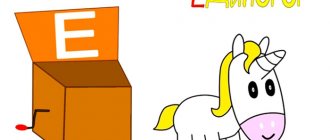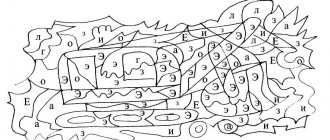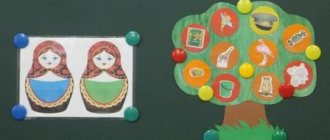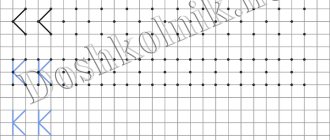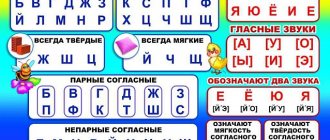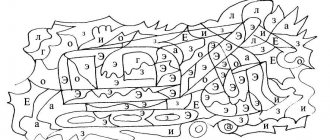Text of the book “Teaching preschool children to read and write. For classes with children 3-7 years old"
Lesson plans for the preparatory group
Lesson 1 Program content
. Development of the ability to perform sound analysis of words; distinguish between hard and soft consonants, stressed and unstressed vowels. Improving the ability to select words with a given sound.
Material
.
Demonstration:
board, pointer, five-sound word diagram, red, blue, green and black chips.
Handout:
five-sound word diagrams, pointers, red, blue, green and black chips, prize chips.
Progress of the lesson
The lesson is conducted with the whole group of children.
The teacher invites the children to remember what our speech consists of: it consists of words, words - of sounds and syllables. There are different sounds - stressed and unstressed vowels, hard and soft consonants. Sounds are indicated by chips of the corresponding colors (an unstressed vowel is a red chip, a stressed vowel is red and additionally black, a hard consonant is blue, a soft consonant is green).
Sound analysis of the word “book”.
There is a diagram of the word on the board. The teacher calls five children in turn to perform a sound analysis. Children determine the stressed vowel sound and its place in the word. Then the emphasis is transferred to the second syllable and the resulting word is pronounced. Then they pronounce the normative version of the word.
Game “Name the words with the sound h.”
For example:
seagull, mast, ball, reads, dream, Easter cake
, etc. (the consonant sound
h is
always soft).
Lesson 2
Program content
. Development of the ability to perform sound analysis of words; qualitatively characterize sounds. Improving the ability to select words with a given sound.
Material
.
Demonstration:
board, pointer, five-sound word diagram, red, green, black and blue chips.
Handout:
five-sound word diagrams, pointers, red, blue, green and black chips, prize chips.
Progress of the lesson
Sound analysis of the word "handle".
Placing emphasis. Transfer of stress. Reading a word with transferred stress. Reading the word is normative.
Game "Live sounds".
The word
pen.
Game “Name the words with the sound th”.
For example:
pit, cabin, swarm
, etc.
Lesson 3
Program content
.
Development of the ability to perform sound analysis of words; qualitatively characterize sounds, put emphasis. Acquaintance with the vowels A, Z
(uppercase and lowercase), the rules for writing them after consonants. Teaching the ability to build a sound-letter model. Development of the ability to select words to a three-, four-, five-sound model.
Material
.
Demonstration:
board, pointer, chips in red, blue, green and black;
cards with the letters A, Z
in red (2 uppercase and 4 lowercase);
chalk, three-, four-, five-sound word schemes, object pictures depicting a ball, forest, whale, saw, vase, spinning top, lamp, desk, pear. Handout:
chips in red, blue, green and black;
cards with the letters A, Z
in red (2 uppercase and 4 lowercase), pointers.
Progress of the lesson
Sound analysis of the word "ball".
The teacher introduces children to the lowercase letter
a
and the rule for writing it after a hard consonant sound: “If after a hard consonant sound the sound I is heard, then the letter
a is written.”
Children replace the red chip with the letter
a.
The teacher introduces the children to the capital letter A
, explains that names of people, names of animals, names of cities, rivers, seas, etc. are written with a capital letter.
Sound analysis of the word "Anya".
The teacher introduces children to the lowercase letter
I
and the rule for writing it after a soft consonant sound: “If after a soft consonant sound the sound I is heard, then the letter
I is written.”
Children replace the red chip with the letter
I.
Game "Pick up a picture."
There are object pictures on the board, and three-, four-, and five-sound word models at the bottom.
Children name the pictures, match the number of sounds in them with the diagrams, and use arrows to connect the pictures and diagrams. Lesson 4
Program content.
Development of the ability to perform sound analysis of words using the sound-letter model.
Repetition of the rules for writing the letters A, Z
after consonant sounds.
Acquaintance with the iotized function of the letter Y.
Development of the ability to select words to a pattern consisting of three sounds.
Material
.
Demonstration:
board, pointer, chips in blue, green, red and black;
cards with the letters A, Z
in red.
Handout:
chips in red, blue, green and black;
pointers; cards with the letters A, Z
in red; prize chips.
Progress of the lesson
Sound analysis of the word "ball".
Children repeat the rules for writing the letter
Z
after soft consonant sounds.
(One child works at the board.) The teacher, together with the children, recalls the “secret” of the sound h
(always a soft consonant).
Sound analysis of the word "pit".
The teacher explains the rule for writing the letter
I:
“If two sounds are heard nearby in a word -
th
and
a,
then the letter I is written.
For example: apple, anchor, army, lighthouse...”
Children put emphasis on the word pit.
Read the word and name the stressed vowel sound (the first sound
a).
One child works at the board.
Game "Name the words."
The teacher invites the children to come up with words according to the model: hard consonant, vowel, hard consonant sounds.
For example: poppy, cancer, house, smoke, cat, cheese, tank, steam, ball, car, side, nose, forehead, mouth, onion.
For each correctly named word, the child receives a chip.
If the children find it difficult, the teacher can ask them to guess a riddle, for example: from the chimney comes... (smoke),
we built a beautiful...
(house),
a crow sits on a branch and screams...
(kar),
Pinocchio had a long, long...
(nose)
, etc.
Lesson 5
Program content.
Development of the ability to perform sound analysis of words using a mixed (sound-letter) model.
Acquaintance with the vowels O
, E
(uppercase and lowercase), the rules for writing them after consonants.
Development of the ability to name words with a given sound. Material
.
Demonstration:
board, pointers, chips in red, blue, green and black;
cards with the letters A, Z, O, E
(2 uppercase and 4 lowercase);
ball. Handout:
chips in red, blue, green and black;
cards with the letters A, Z, O, E
(2 uppercase and 4 lowercase); prize chips; pointers.
Progress of the lesson
Game "Name the Pair".
Children stand in a circle. The teacher names a hard consonant sound and throws the ball to the child, who names a soft sound and returns the ball. Then the game is played in reverse: the presenter names a soft consonant sound, and the children name its hard pair.
Sound analysis of the word "gender".
The teacher introduces children to the lowercase letter
o
and the rule for writing it after a hard consonant sound: “If after a hard consonant sound the sound o is heard, then the letter o is written.”
Children replace the red chip with a
red
o The teacher introduces the children to the capital letter O.
Sound analysis of the word “maple”.
The teacher introduces children to the lowercase letter
e
and the rule for writing it after a soft consonant sound: “If after a soft consonant sound the sound o is heard, then the letter
e is written.”
Children replace the red chip with the
red e
Game “Name the words with the sound z.”
Children remember the “secret” of the sound
z
(always hard).
Lesson 6
Program content.
Development of the ability to perform sound analysis of words using a mixed model.
Repetition of the rules for writing the letters A, Z, O, E
after consonant sounds.
Acquaintance with the iotized function of the letter E.
Development of the ability to select words to a three-sound model.
Material
.
Demonstration:
board, pointer, chips in red, blue, green and black;
cards with the letters A, Z, O, E
(2 uppercase and 4 lowercase).
Handout:
chips in red, blue, green and black;
cards with the letters A, Z, O, E
(2 uppercase and 4 lowercase); pointers; prize chips.
Progress of the lesson
Sound analysis of the word "mint".
Children put emphasis on the word and repeat the rules for writing the letters
A, Z, O, E
after consonants.
Sound analysis of the word "Christmas tree".
The teacher explains the rule for writing the letter
e:
“If two sounds are heard nearby in a word,
it
and
o.
then the letter
e is written,
for example:
hedgehog, border, ruff, sings, pecks...”
Children put emphasis on the word fir-tree.
Read the word and name the shock sound (
o sound).
Game "Name the words."
The teacher invites the children to come up with words according to the model: soft consonant, vowel, hard consonant sounds.
For example: forest, whale, honey, iodine, shooting range, feast, sang, drank, peace, rice, weight, dog.
For each correct answer, children receive chips.
Lesson 7
Program content.
Development of the ability to perform sound analysis of words using a mixed model.
Acquaintance with the vowels U, Yu
(uppercase and lowercase), the rules for writing them after consonants. Development of the ability to name words with a given sound.
Material
.
Demonstration:
board, pointer, chips in red, blue, green and black;
cards with the letters A, Z, O, E, U, Yu
(2 uppercase and 4 lowercase).
Handout:
chips in red, blue, green and black;
cards with the letters A, Z, O, E, U, Yu
(2 uppercase and 4 lowercase); pointers; prize chips.
Progress of the lesson
Sound analysis of the word "onion".
The teacher introduces children to the lowercase letter
y
and the rule for writing it after a hard consonant sound: “If after a hard consonant sound the sound
y is heard,
then the letter y is written.”
Children replace the red chip with
red letter.
The teacher introduces the children to the capital letter U.
Sound analysis of the word “hatch.”
The teacher introduces children to the lowercase letter
yu
and the rule for writing it after a soft consonant sound: “If after a soft consonant sound the sound
y is heard,
then the letter
yu is written.”
Children replace the red chip with the
red
yu The teacher introduces the children to the capital letter Y.
Game “Name the words with the sound w.”
Children remember the “secret” of the sound
sh
(always hard).
Lesson 8
Program content.
Development of the ability to perform sound analysis of words using a mixed model.
Reviewing the rules for writing vowels after consonants. Introducing the iotized function of the letter Y.
Development of the ability to select words to a three-sound model.
Material.
Demonstration:
board, pointer, chips in red, blue, green and black;
cards with the letters A, Z, O, E, U, Yu
(2 uppercase and 4 lowercase).
Handout:
chips in red, blue, green and black;
cards with the letters A, Z, O, E, U, Yu
(2 uppercase and 4 lowercase); pointers; prize chips.
Progress of the lesson
Game “Who is the most attentive?”
The teacher places a blue chip on the board, followed by vowels, which are written after the hard consonant sound
(a, o, u).
Below he places a green chip, and behind it are vowels, which are written after a soft consonant sound
(i, e, yu).
Children close their eyes, and the teacher swaps vowel letters or chips. The guys open their eyes and check whether the vowels are now positioned correctly. The game is played 2-3 times.
Sound analysis of the word "yula".
The teacher explains the rule for writing the letter
yu:
“If two sounds are heard nearby in a word -
y
and
y,
yu
is written for example:
Yura, cabin, skirt, computer, sing, draw...”
Children put emphasis on the word yula.
Read the word and name the stressed sound (sound
y).
Game "Name the words."
The teacher invites the children to come up with words according to the model: hard consonant, vowel, soft consonant sounds.
For example: horse, elk, pain, zero, mine, may, moth, salt, lynx, measles, night, daughter.
For each correct answer, children receive chips.
Lesson 9
Program content
.
Development of the ability to perform sound analysis of words using a mixed model. Reviewing the rules for writing vowels after consonants. Acquaintance with the vowels Y
, I
(uppercase and lowercase), the rules for writing them after consonants.
Development of the ability to select words to a three-sound model. Material
.
Demonstration:
board, pointer, chips in red, blue, green and black;
cards with the letters A, Z, O, E, U, Yu, Y, I
(2 uppercase and 4 lowercase).
Handout:
chips in red, blue, green and black;
cards with the letters A, Z, O, E, U, Yu, Y.
And (2 uppercase and 4 lowercase); pointers, prize chips.
Progress of the lesson
Game “Who is the most attentive?”
The role of the leader can be offered to a child who knows the rules of the game well. (See lesson 8, preparatory group.)
Sound analysis of the word "melon".
The teacher introduces children to the lowercase letter
s
and the rule for writing it after a hard consonant sound: “If after a hard consonant sound the sound
s is heard,
then the letter
s is written.”
Children replace the red chip
with
red letter s.
The teacher explains that there is no capital letter y
in the Russian language.
Sound analysis of the word "lemon".
The teacher introduces children to the lowercase letter
and
and the rule for writing it after a soft consonant sound: “If after a soft consonant sound the sound
and
, then the letter
and is written.”
Children replace the red chip with a letter
and
the color is red.
The teacher introduces the children to the capital letter I.
Children remember which words are written with a capital letter.
The teacher calls five children in turn to figure out the word lemon
, put emphasis.
Then the teacher suggests making
the word
lemons lemon.
Game "Name the words."
The teacher invites the children to come up with words according to the model: a hard consonant sound, a sound
and
a hard consonant sound.
For example: varnish, poppy, cancer, tank, so, VAZ, steam, var, gas, basin, car, ball, shaft, sam, small, garden.
For each correct answer, children receive chips.
Lesson 10
Program content
.
Improving the ability to perform sound analysis of words using a mixed model. Acquaintance with the vowels E, E
(uppercase and lowercase), the rules for writing them after consonants. Development of the ability to select words to a three-sound model.
Material
.
Demonstration:
board, pointer, chips in red, blue, green and black;
cards with the letters A, Z, O, E, U, Yu, Y, I, E, E
(2 uppercase and 4 lowercase).
Handout:
chips in red, blue, green and black;
cards with the letters A, Z, O, E, U, Yu, Y, I, E, E
(2 uppercase and 4 lowercase); pointers, prize chips.
Progress of the lesson
Sound analysis of the word "echo".
The teacher introduces the children to the vowel letter
E
(uppercase and lowercase).
Children replace the red chip with the letter e
in red.
Sound analysis of the word "stove".
The teacher introduces children to the lowercase letter
e
and the rule for writing it after a soft consonant sound: “If after a soft consonant sound the sound e is heard, then the letter
e is written.”
Children replace the red chip with the letter
e
in red.
The teacher introduces the children to the capital letter E.
Children remember the “secret” of the sound h
(always soft).
Game "Name the words."
The teacher invites the children to come up with words according to the model: a hard consonant sound, an
o
and a hard consonant sound.
For example: side, current, horn, catfish, sleep, cat, mouth, forehead, nose, cart, rum, tom, bom, won, crowbar, goal.
For each correct answer, children receive chips.
Lesson 11
Program content.
Improving the ability to perform sound analysis of words using a mixed model.
Reviewing the rules for writing vowels after consonants. Acquaintance with the iotized function of the vowel letter E.
Development of the ability to name words with a given sound.
Material
.
Demonstration:
board, pointer, chips in red, blue, green and black;
cards with vowel letters A, Z, O, E, U, Yu, Y, I, E, E
(2 uppercase and 4 lowercase).
Handout:
chips in red, blue, green and black;
cards with vowel letters A, Z, O, E, U, Yu, Y, I, E, E
(2 uppercase and 4 lowercase); pointers, prize chips.
Progress of the lesson
Sound analysis of the word "raccoon".
The teacher explains the rule for writing the letter
e
“If two sounds are heard nearby in a word
- th
and e, then the letter e is written
,
for example:
spruce, Egor, drove, drove up, ate, fan, necklace...”
Game “Who is the most attentive?”
(See lesson 8, preparatory group.)
Game “Name the words with the sound t.”
Lesson 12
Program content.
Improving the ability to perform sound analysis of words using a mixed model. Reviewing the rules for writing vowels after consonants. Development of the ability to select words to a three-sound model.
Material.
Demonstration:
board, pointer, chips in red, blue, green and black;
cards with vowel letters A, Z, O, E, U, Yu, Y, I, E, E
(2 uppercase and 4 lowercase).
Handout:
chips in red, blue, green and black;
cards with vowel letters A, Z, O, E, U, Yu, Y, I, E, E
(2 uppercase and 4 lowercase); pointers, prize chips.
Progress of the lesson
Game "Find your house."
The teacher selects two children to play the role of leaders (they should know well the rules for writing vowels after consonant sounds). He gives one child a blue chip, the other a green one. The teacher distributes cards with letters to the rest of the children.
The teacher invites the “letter” children to go for a walk. Children “letter-you” move freely around the group. The teacher says that the weather has turned bad, it started to rain and the letters, in order to “not get wet,” must quickly hide in their “houses.” Children holding cards with the letters a, o, u, s, e,
approach the child with a blue chip; preschoolers, who have cards with the letters
i, е, ю, и, е,
approach the child with a green chip. Then the correctness of the task is checked.
The game is repeated 2-3 times.
Sound analysis of the word "keys".
One child works at the board, the rest work on the ground.
(Putting emphasis. Repeating the rules for writing vowels yu, and
after soft consonant sounds.)
Sound analysis of the word "grater".
One child works at the board, the rest work on the ground.
(Putting emphasis. Repeating the rule for writing the letter e
after a soft consonant sound.)
Game "Name the words."
The teacher asks the children to come up with words according to the model: hard consonant sound,
y sound,
hard consonant sound.
For example: bow, beech, bough, court, here, knock, jester, fluff, meadow, blow, mule, rumble, Nuf-Nuf,
etc. For each correct answer, children receive chips.
Lesson 13
Program content
. Improving the ability to perform sound analysis of words using a mixed model. Reviewing the rules for writing vowels after consonants. Development of the ability to select words to a three-sound model.
Material
.
Demonstration:
board, pointer, chips in red, blue, green and black;
cards with vowel letters A, Z,
O, E, U, Yu, Y, I, E, E
(2 uppercase and 4 lowercase).
Handout:
chips in red, blue, green and black;
cards with vowel letters A, Z, O, E, U, Yu, Y, I, E, E
(2 uppercase and 4 lowercase); pointers, prize chips.
Progress of the lesson
Game "Find your house."
Children choose their own presenters. (See lesson 12, preparatory group.)
Sound analysis of the word "Tanya".
One child works at the board, the rest work on the ground. (Repeat the rule for writing the letter I after soft consonant sounds.)
Sound analysis of the word "Denis".
One child works at the board, the rest work on the ground.
(Repetition of the rules for writing letters e, and
after soft consonant sounds.)
Game "Name the words."
The teacher invites the children to come up with words according to the model: soft consonant sound, sound
and,
hard consonant sound.
For example: drank, lil, pitchfork, rice, fox
, etc. For each correct answer, children receive chips.
Lesson 14
Program content
. Improving the ability to perform sound analysis of words using a mixed model. Reviewing the rules for writing vowels after consonants. Mastering the action of changing words. Development of the ability to name words with a given sound.
Material
.
Demonstration:
board, pointer, chips of red, blue, green, black and gray [9]
9
When analyzing words, children use chips of all colors to indicate consonant sounds, and when changing words, they take gray chips.
[Close]; cards with vowel letters A, Z, O, E, U, Yu, Y, I, E, E
(2 uppercase and 4 lowercase letters).
Handout:
chips in red, blue, green, black and gray;
cards with vowel letters A, Z, O, E, U, Yu, Y, I, E, E
(2 uppercase and 4 lowercase); pointers, prize chips.
Progress of the lesson
Sound analysis of the word "pants".
Four children take turns working at the board.
(Putting emphasis. Repeating the rules for writing vowels yu, and
after soft consonant sounds.)
Game "Live sounds".
The word
is pants.
Changing words.
The teacher invites the children to compose the word
onion,
using gray chips to indicate consonant sounds and letters to indicate vowel sounds. The teacher works at the board, and the children work in their seats.
Then the teacher asks the children to replace the letter y
letter
yu
and read the resulting word.
(Luke.)
The teacher reminds that only one vowel letter in the word was changed
(u
to
yu),
the sound
k
did not change (remained a hard consonant), and the sound l began to sound soft - l (became a soft consonant).
The teacher replaces the letter u
letter
a
(children do the same).
The guys read a new word - varnish.
The teacher draws the children's attention to the fact that the first consonant has again become hard (l). The teacher explains: “We change only one vowel letter, but we get new words.”
Game “Name the words first with the sound f, then with the sound f.”
Goals and objectives
The main goal of the classes is for the child to master the rules for writing the letter E and the principles of using it in words of different parts of speech, as well as the development of recognition skills for this symbol.
Teaching a child to distinguish the letter E from others, to write it beautifully and legibly, to consciously use it in words, and to pronounce this sound correctly are the main tasks. It is advisable to arouse interest in learning letters with the help of fairy tales, poems, riddles and exciting games for preschoolers.
Learning the alphabet with young children is difficult, but if you conduct lessons on the topic “Letter E” correctly, then problems will no longer arise throughout the entire training.
